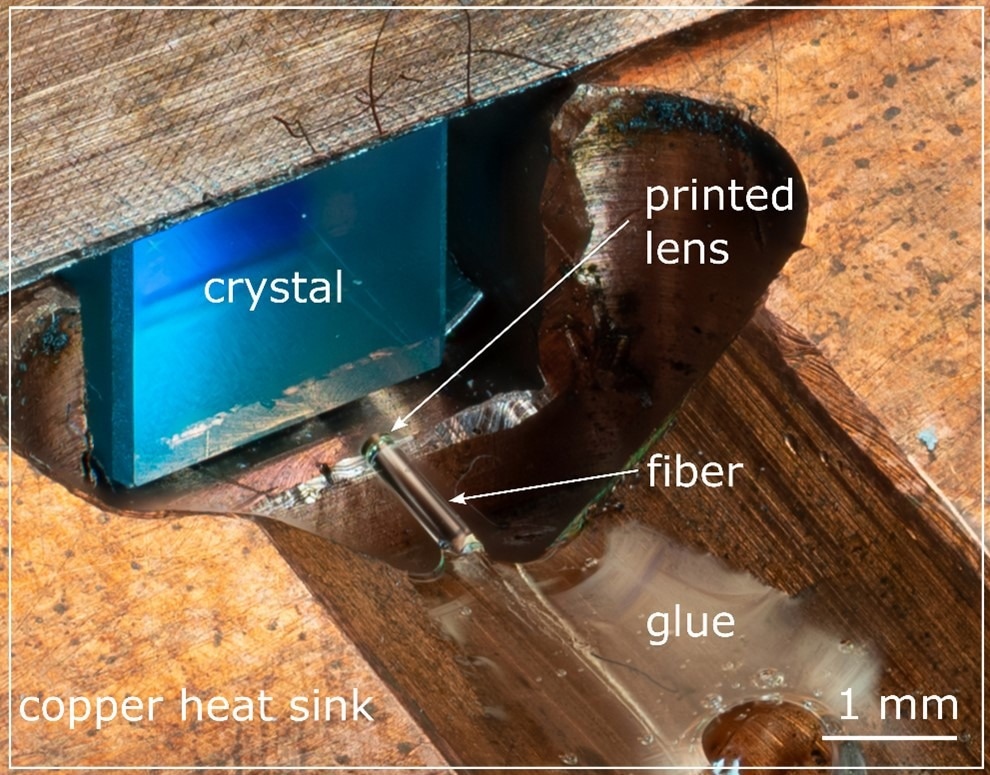Researchers have demonstrated for the first time that 3D-printed polymer-based micro-optics are capable of withstanding the heat and power levels seen inside lasers.
 Researchers printed microscale lenses directly onto optical fibers, allowing them to compactly combine fibers and laser crystals inside a single laser oscillator. Image Credit: Moritz Floess and Simon Angstenberger, 4th Physics Institute at University of Stuttgart in Germany
Researchers printed microscale lenses directly onto optical fibers, allowing them to compactly combine fibers and laser crystals inside a single laser oscillator. Image Credit: Moritz Floess and Simon Angstenberger, 4th Physics Institute at University of Stuttgart in Germany
This development makes it possible to create robust, low-cost, small laser sources that can be utilized for many different purposes, such as lidar systems in driverless cars.
We significantly reduced the size of a laser by using 3D printing to fabricate high-quality micro-optics directly on glass fibers used inside of lasers. This is the first implementation of such 3D-printed optics in a real-world laser, highlighting their high damage threshold and stability.
Simon Angstenberger, Research Team Leader, 4th Physics Institute, University of Stuttgart
The researchers explain how they compactly combined fibers and laser crystals into a single laser oscillator by 3D printing microscale optics directly onto optical fibers in the Optica Publishing Group journal Optics Letters. The resultant hybrid laser has a maximum output power of 37 mW and demonstrated stable operation at output powers of over 20 mW at 1063.4 nm.
This new laser merges the compactness, durability, and cost-effectiveness of fiber-based lasers with the versatile properties of crystal-based solid-state lasers. Crystal-based lasers offer a spectrum of features, including varying powers and colors, enhancing the overall capabilities of this hybrid laser.
Until now, 3D-printed optics have primarily been used for low power applications such as endoscopy. The ability to use them with high power applications could be useful for lithography and laser marking, for example. We showed that these 3D micro-optics printed onto fibers can be used to focus large amounts of light down to a single point, which could be useful for medical applications such as precisely destroying cancerous tissue.
Simon Angstenberger, Research Team Leader, 4th Physics Institute, University of Stuttgart
Taking the Heat
The 4th Physics Institute at the University of Stuttgart boasts a rich legacy in pioneering 3D-printed micro-optics, notably the capability to directly print them onto fibers. Their technique involves a method called two-photon polymerization within 3D printing, where an infrared laser targets a UV-sensitive photoresist.
In the focal region of the laser, the simultaneous absorption of two infrared photons triggers the hardening of the UV resist. Precise movement of the focus enables the creation of diverse shapes with exceptional accuracy. This innovative approach not only facilitates the production of miniaturized optics but also unlocks new possibilities, such as crafting free-form optics and intricate lens systems.
Because these 3D-printed elements are made of polymers, it was unclear whether they could withstand the significant amount of heat load and optical power that occurs inside a laser cavity. We found that they are surprisingly stable, and we were not able to observe any kind of damage on the lenses even after several hours of running the laser.
Simon Angstenberger, Research Team Leader, 4th Physics Institute, University of Stuttgart
In the latest work, the researchers employed two-photon polymerization to create lenses with a 0.25 mm diameter and 80 micron height on the end of a fiber with the same diameter. They did this using a Nanoscribe 3D printer. This included using commercial software to create an optical element, putting the fiber into the 3D printer, and producing the little structure on the fiber’s end. The printing accuracy and the alignment of the print to the fiber require an exceptionally accurate technique.
Creating a Hybrid Laser
The researchers assembled the laser and the laser cavity once the printing was finished. They created a hybrid fiber-crystal laser by utilizing fibers to form a portion of the cavity rather than a large, expensive mirror used to house a crystal inside the laser.
Light is focused and collected, or “coupled,” into and out of the laser crystal by means of the lenses printed at the end of the fibers. To make the laser system less prone to air turbulence and more stable, they bonded the fibers into a mount. Measuring only 5 by 5 cm2, the crystal and the printed lenses were small.
A continuous recording of laser power conducted over several hours confirmed that the printed optics within the system remained stable, showing no signs of degradation or impact on the laser's long-term properties. Furthermore, examination via scanning electron microscopy revealed no visible damage to the optics after being utilized in the laser cavity.
The researchers are presently focused on enhancing the efficiency of the printed optics. Their efforts involve exploring larger fibers integrated with optimized freeform and aspherical lens designs, or, potentially a fusion of lenses directly printed onto the fiber. This approach aims to enhance the output power of the system. Additionally, they aim to showcase various crystals within the laser, enabling tailored output for specific applications.
Journal Reference:
Angstenberger, S., et al. (2023). Hybrid fiber–solid-state laser with 3D-printed intracavity lenses. Optics Letters. doi.org/10.1364/OL.504940